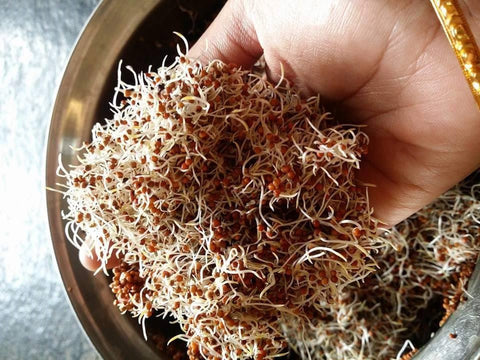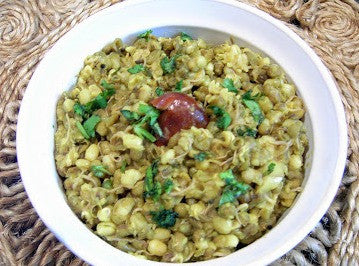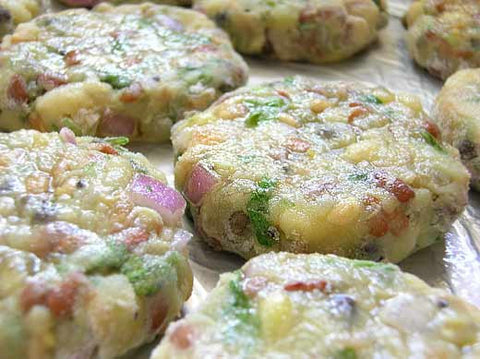Sprouting whole grains is an ancient culture and has tremendous nutritional benefits when eaten regularly. Read a detailed article describing 11 benefits of eating sprouts.
Sprouting is a practice of germinating seeds that can be eaten raw or cooked. Sprouts can be germinated easily at home and we will show you how.
The Germination Process
The germination process takes a couple of days and all you need is a bowl, muslin cloth and some water.
- Clean & Soak: Wash the grains in water to remove soil and dirt. Then Soak 5-12 hours, depending on the type and size of seeds. Larger grains require longer soaking time. Smaller ones require about 5-6 hours.
- Drain & Cover: Drain off all the water from the bowl. Put the drained grains into a clean muslin cotton cloth and cover them well. Leave it untouched at a corner for 10 hours. They will naturally sprout.
- Sprinkle Water: Occasionally, sprinkle some water on the muslin wrap, so that the sprouts don’t get dried up.
- Store: When the tails are just barely visible, place the sprouts in an airtight container and store them in your fridge. They'll continue to sprout more slowly.
- Instant Use Idea: You can also dry the sprouts well at room temperature and store for instant use in your recipes. You can use as is, or powder them and add to soups, rotis, gravy to make it thicker etc.
Note: Any vessel used for sprouting must allow water to drain from it, because sprouts that sit in water will rot quickly.
Some grains are rinsed two to four times a day, depending on the climate and the type of seed, to provide them with moisture and prevent them from souring. Each seed has its own ideal sprouting time. After three to five days the sprouts will have grown to 5 to 8 cms in length and will be suitable for consumption. If left longer they will begin to develop leaves, and are then known as baby greens. Refrigeration can be used as needed to slow or halt the growth process of any sprout.
What grains can be sprouted?

- Green Moong - This is the most common form of sprout .They can be sprouted either in light or dark conditions. Those sprouted in the dark will be crisper in texture and whiter.
- Chickpea - (small brown chana used in panipuri) -The nutty, mild taste of chickpea sprouts makes these sprouts a popular ingredient in many Asian dishes
- Lentils - (Daal) Lentils are oval seeds that are derived from the pods of bushy pea related plants and come in large range of colors like orange ,green ,yellow etc. These sprouts have a nutty peppery taste and are a great source of iron.
- Snow peas (matar) - Snow peas come from the sugar-pod type of pea plant where the whole pod can be eaten. The sprouts have the top set of leaves of the pea plant and taste sweeter than green pea sprouts.
- Beans - Commonly sprouted beans or legumes include adzuki beans, chickpeas, Kabuli chana, green peas, red kidney beans (rajma) and soy beans. Many people find that the initial soaking step alone renders the beans more digestible. Fully sprouting the beans softens them enough that they may be eaten raw, whizzed into soups, blended to make spreads like hummus, or lightly cooked.
- Nuts- Many varieties of nuts, such as almonds and peanuts, can also be started in their growth cycle by soaking and sprouting, although because the sprouts are generally still very small when eaten, they are usually called "soaks".
- Seeds- Other commonly sprouted seeds include broccoli, celery, chia, clover, fenugreek, radish, kale, onion, pumpkin, sesame, and sunflower. In most cases, since the seeds are so small, you'll want to sprout just a couple tablespoons of seeds at a time or you'll end up with a lot of sprouts.
- Grains- You can sprout mostly all grains in the same procedure as explained above. Grains like ragi, wheat ,barley, bajra and other millets can be used for sprouting. Its best to consume the grain sprouts within 2 days of its germination while its fresh to avoid any bacteria forming on the same.
Common causes for sprouts to become inedible:
- Seeds are not rinsed well enough before soaking
- Seeds are left in standing water after the initial soaking
- Seeds are allowed to dry out
- Temperature is too high or too low
- Dirty equipment
- Insufficient air flow
- Contaminated water source
- Poor germination rate.
Some important things to note:
- Always ensure you are using clean drinking water for sprouting
- Ensure you steam or cook the sprouts well especially when feeding them to your babies.
- Check on time and quantity of water used in sprouts. Sprouts left in too much water can rot and is not usable.
- Always consult your health care practitioner before introducing new foods to your infant.
Hope you liked this article on the basics of sprouting procedures. Feel free to ask questions or share your feedback in comments below.























Comments (0)
There are no comments for this article. Be the first one to leave a message!